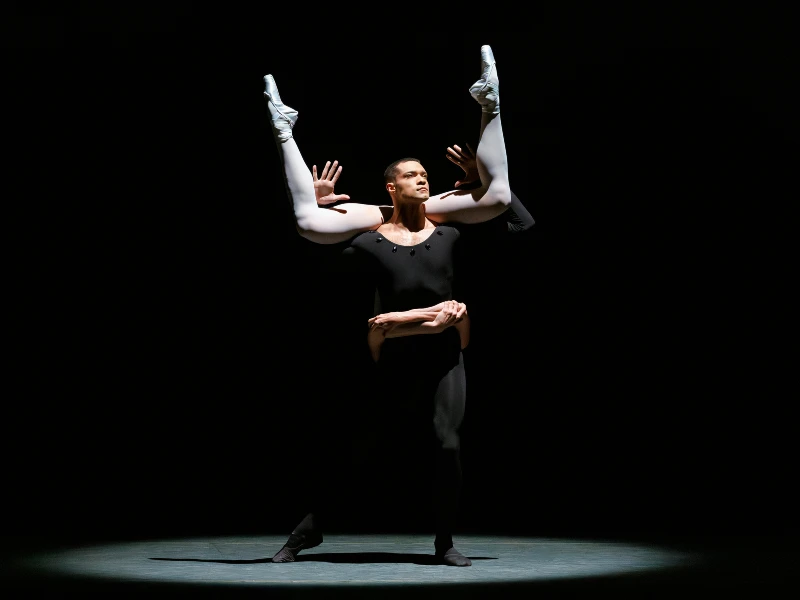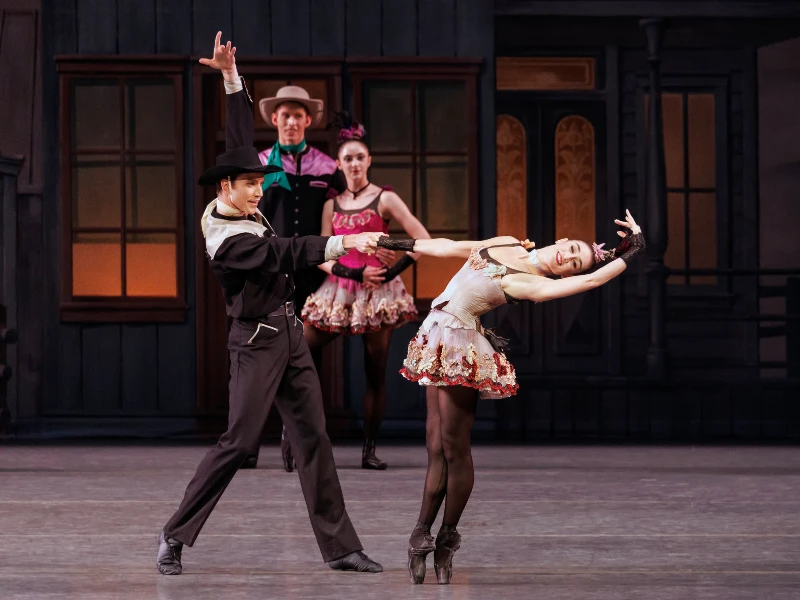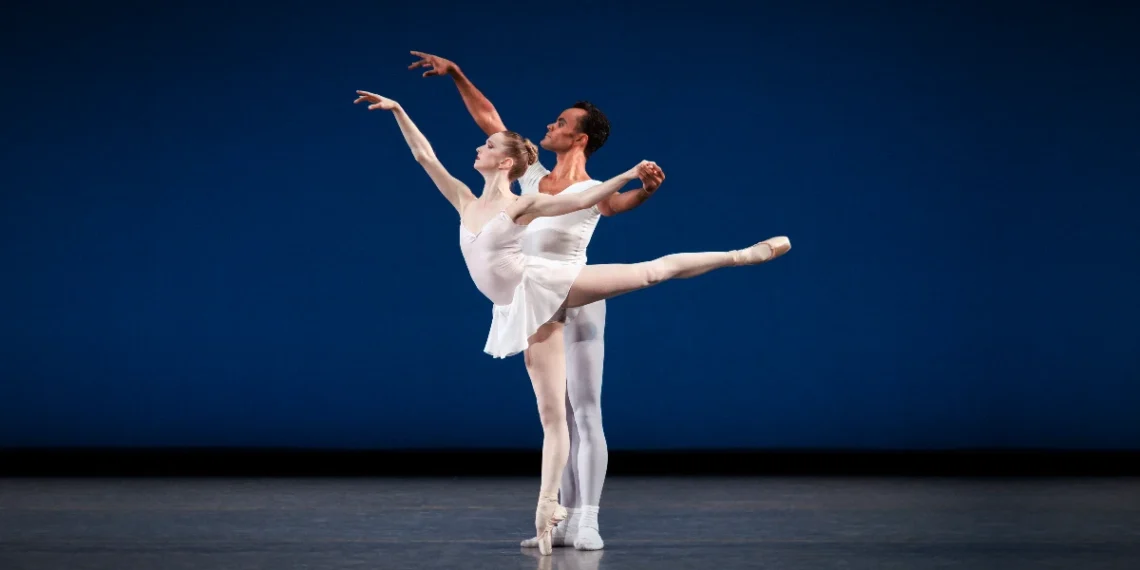NYCB All Balanchine II Review
September 27, 2025 | David H. Koch Theater – New York, NY, USA
This fall season at the Lincoln Center, the New York City Ballet All Balanchine II bill featured three contrasting ballets: the sublime and lyrical Square Dance, the thorny and angular Episodes, and the exuberant and showy Western Symphony.
The program proved a meticulously curated homage to George Balanchine, unfolding like a study in contrasts and revealing the choreographer’s vast range of styles and musical choices.
Each work showcased a distinct facet of Balanchine’s choreographic voice, offering the audience a journey from neoclassical elegance to modernist abstraction, culminating in a rousing finale steeped in Americana flair.
You may also like...
2025 Fall For Dance Review: Wild Dancing in Midtown Eclipses A Holy Duet
This 2025 Fall For Dance review of Dog Rising, RESURRECTION, and IMPASSE explores whether overpacking choreography is a tactic to cover up a lack of direction.
Birmingham Royal Ballet Black Sabbath – The Ballet Review: Rebellion, Passion, and Legacy
Black Sabbath - The Ballet review: Unexpected highlights in a performance that paid tribute to the late Ozzy Osbourne, the iconic lead singer of the band.
NYCB All Balanchine II Review
Square Dance is both a celebration of American folk spirit and a testament to classical purity. Here the choreography is a masterful synthesis of two seemingly disparate worlds: the communal joy of square dancing and the refined exactitude of classical ballet.
When the ballet premiered in 1957, there was a live caller onstage shouting the steps as if navigating the dancers. In 1976, Balanchine revamped and modernized the piece. He stripped away the caller and the elaborate costumes, leaving behind a sleek, leotard-clad ensemble. He also added a poignant male solo that deepened the ballet’s emotional resonance.
The architectural patterns of the corps de ballet in Square Dance are simply mesmerizing. During the performance, the NYCB female ensemble was in fine form, dancing with clarity and precision, allowing the choreography, set to the music of Vivaldi and Corelli, to unfold like a visual fugue.
Yet it was the principal couple, the effervescent Emma Von Enck and the composed and luminous Taylor Stanley, that made a particular impression on me.
Von Enck danced with a crystalline precision, her footwork brisk and buoyant, while Stanley brought a quiet intensity to the male solo, his movements imbued with introspection, gravity, and restraint.
The next piece, Episodes, brings the audience into a stark and enigmatic world of modernism and abstraction.
Set to the atonal music of Anton von Webern, the ballet (true to its title) unfolds as a series of short episodes, each movement shaped by emotional undercurrents of the music and ingenious architectural designs.
From the first opening bars of Webern’s Symphony, Op. 21, the dancers enter the stage not as characters, but as kinetic lines in space, their limbs carving intricate angles and shapes with mathematical precision.
Balanchine’s choreography here is as austere and perplexing as the score to which the ballet is set, creating the minimalist landscape where even the smallest movement carries a substantial visual and emotional weight.
This is not an easy ballet to pull off. Yet the company’s dancers were admirable throughout the performance.
In the opening “Symphony,” India Bradley and Tyler Angle looked impressive; Bradley’s spiky extensions and off-balance tilts created a sense of cool detachment, mirrored by her partner’s taut, understated support. Their duet was less an exchange of emotion than a study in tension and release, distance and proximity.

In “Five Pieces,” Emily Kikta and Preston Chamblee brought to the forefront the mystery of the music and the choreography in their dreamy and haunting duet which evoked a poignant encounter between a woman and a man amid a mesmerizing interplay of darkness and light.
Yet, in my opinion, the finest dancing came from Miriam Miller and Aarón Sanz in the closing section of the ballet, “Ricercata.”
Flanked by the 14-member strong ensemble, both dancers navigated the challenges of the choreography with an impeccable exactitude and assurance.
Perhaps most striking in this performance was the entire cast’s ability to navigate the ballet’s silences.
Webern’s score often fades into near nothingness, yet the dancers held the space with quiet authority, making visible the music’s internal architecture. This sensitivity to nuance is what made NYCB’s rendition of Episodes feel so alive.
In Western Symphony, Balanchine’s high-spirited tribute to the mythic American West, New York City Ballet delivered a performance that sparkled with wit, technical bravura, and a keen sense of theatrical flair.
Set to Hershy Kay’s orchestration of traditional American folk tunes, the ballet reveals Balanchine at his most playful and exuberant. It’s an indisputable crowd-pleaser and, with its rousing finale, a perfect way to end any program.

From the opening tableau, with a stage full of high-kicking cowgirls and swaggering cowboys, the ensemble brought both polish and personality to Balanchine’s stylized vision of Old West.
There is no narrative here, only a sequence of virtuosic dances infused with humor, charm, and the choreographer’s keen musical intelligence.
Alexa Maxwell and Alec Knight danced with an invigorating spark and swagger in the opening “Allegro.” Olivia MacKinnon and Victor Abreu, combining humor and skills, made an impressive turn in “Adagio;” and Isabella LaFreniere and Ryan Tomash looked simply irresistible in the final “Rondo,” dancing with sunny disposition and bravura.
Featured Photo of New York City Ballet dancers Emma Von Enck and Taylor Stanley in George Balanchine’s Square Dance. Photo by Erin Baiano.










